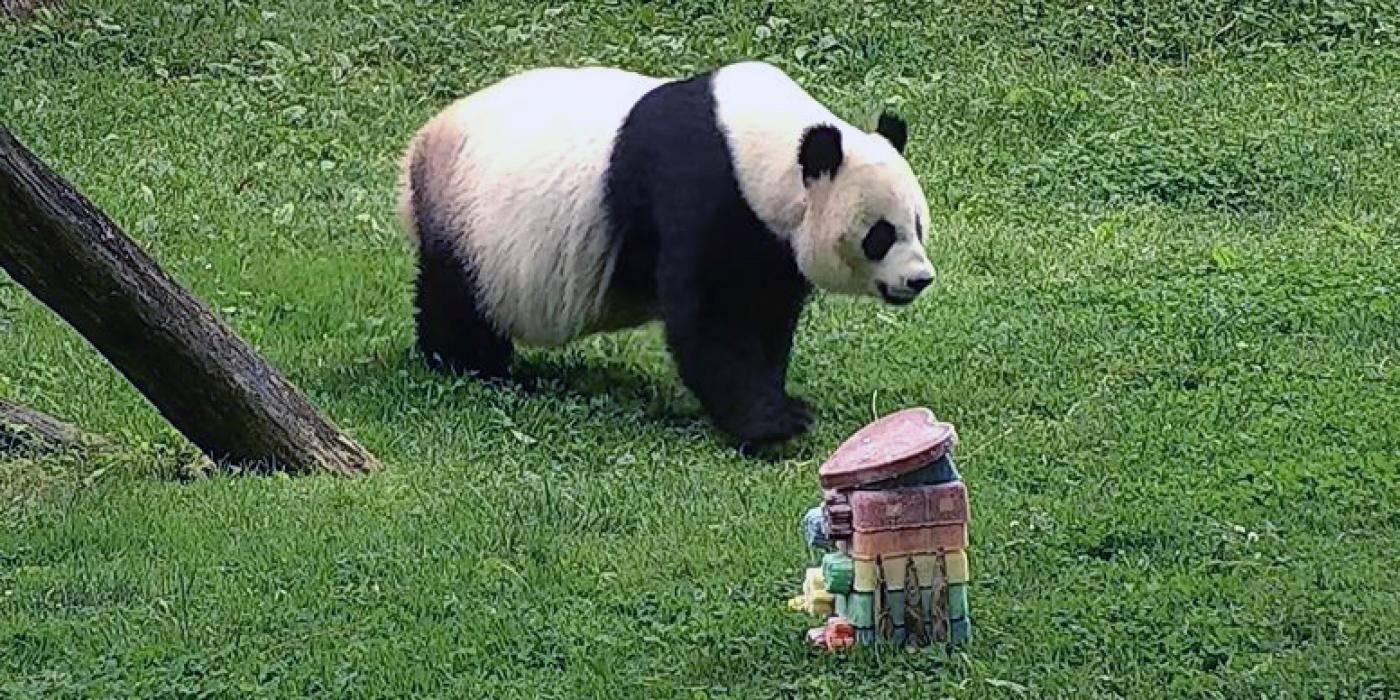Bringing the Zoo To You: June 2020

A family meal among prairie dogs, the soothing sounds of a cheetah’s purr and a Pride cake fit for a giant panda. As summer kicks off at the Smithsonian’s National Zoo and Conservation Biology Institute, we’re sharing some moments from June that sparked joy. While we remain temporarily closed, our keepers work diligently behind the scenes to provide excellent care to all of our creatures, great and small.
Thank you for your continued support. Follow the Zoo’s social media using the hashtag #NatZooZen for more fun updates!
Prairie Dog | Great Cats
Share a family meal with our prairie dog colony. Grasses and leafy vegetation make up 98% of the prairie dogs’ diet. As such, their food provides all of the moisture content that they need—they don’t need to drink water. The Zoo’s animals nosh on leafy greens, root vegetables, herbivore pellets, hay and grass.
Gray Wolf | American Trail
Happiest, howling of birthdays to our grey wolf, Coby! On June 2, Coby celebrated her sweet 16 with a tasty treat from the Commissary. This special “cake,” made by the talented team in our Department of Nutrition Sciences, included some of her favorite foods, including ground beef, herring and kibble.
Cheetah | Cheetah Conservation Station
Unlike lions, tigers and other large cats, cheetahs cannot roar. That’s because their hyoid bone is only one piece, whereas the others’ hyoid bones are comprised of two pieces. Instead, cheetahs vocalize through chirps, growls, stutters and—as this video demonstrates—purrs. Most cheetahs are not relaxed enough to purr when a human is in close proximity, but 8-year-old Gat was hand-raised by keepers and is very comfortable in their presence. The sound is a treat to keepers’ ears!
Two-Toed Sloth | Small Mammal House
Two-toed sloth Athena takes #NatZooZen to a whole new level! This serial chiller sleeps 15 to 20 hours a day, but not because she's lazy. Sloths sleep to conserve the energy they get from their primary diet: leaves. While foliage does not provide a ton of nutrients, sloths' very slow metabolism allows them to function on less.
Guinea Pig | Amazonia
Our guinea pigs are having a ball! Amazonia keepers provide these all-natural toys as enrichment. These items encourage the pigs to move about their habitat and give them a little something extra to nibble. Did you know: Guinea pigs spend only 4% of their day sleeping. They also only sleep for about 6 minutes at a time. Then, they're on the move again!
Black-Footed Ferret | Smithsonian Conservation Biology Institute
By the time our black-footed ferret kits turned one month old June 10, their distinctive “mask” facial markings and the dark fur on their feet began to show. They had also become quite active in the box! It was not uncommon to see the kits playfight with each other. They bite, wrestle and thrash around. These types of play mimic how they hunt prey and allows them to hone their skills safely. Check them out on the webcam.
Cheetah | Smithsonian Conservation Biology Institute
Wrestling and playing with littermates is an important part of development for any aspiring predator. Cheetah cubs in the wild have to learn how to successfully hunt and take down prey if they want to feed themselves when they are older. While our cheetahs do not have to hunt for their food, wrestling and chasing each other allows them to strengthen their athletics and sharpen their dexterity while testing out different techniques. Watch the cubs on the Cheetah Cam.
Lesser Kudu | Cheetah Conservation Station
Let’s spar! Kushukuru, our almost 1.5 year-old lesser kudu, is ready to test his growing horns out against his dad, Garrett. Male lesser kudu begin growing their impressive 3.5 foot horns around the time they turn one. Adults use their horns in shoving matches between males during mating season.
Giant Panda | Asia Trail
“Pride Month reminds us to support one another and celebrate the strength and diversity of our community.” – Smithsonian Secretary Lonnie Bunch
Happy Pride from giant panda Mei Xiang and all of us at Smithsonian's National Zoo!
Making an Animal-Friendly Cake | Department of Nutrition Sciences
Birthdays, holidays and special occasions all share one thing in common at the Smithsonian’s National Zoo: cakes! Meet Brian Cannon, keeper in the Zoo’s Department of Nutrition Sciences and master craftsman of animal-friendly cakes. Go behind-the-scenes of the Commissary and watch him construct Mei Xiang’s amazing panda pride cake.
Guam Kingfisher | Smithsonian Conservation Biology Institute
This month, we have two adorable reasons to celebrate! We shared in April that our newest and youngest Guam kingfisher pair, Animu and Giha, had two fertile eggs. On April 21 and 23, the chicks hatched! They have been keeping bird keepers at the Smithsonian Conservation Biology Institute very busy for the last several weeks. Read all about the new chicks in this update from keeper Erica Royer.
Western Lowland Gorilla | Great Ape House
Western lowland gorilla (and mom to Moke) Calaya is not shy about showing off and enjoys being encouraged whenever she is in a playful mood. She will spin, roll around on the ground, clap and put enrichment toys on her head. As part of the Zoo’s positive reinforcement training program, she and primate keeper Carolina Powell started working on a new behavior called “innovate”—a super fun cue that gives Calaya the opportunity to be creative with the behavior she wants to demonstrate. Powell invites Calaya to create any behavior she thinks of, as long as she doesn’t repeat it. Once she has gone through her normal repertoire of husbandry behaviors, that’s when things get interesting. Occasionally, she comes up with behaviors that are completely new—like thrusting out her bottom lip. Now, Powell has been able to put even more behaviors on cue—and Calaya came up with them herself!
This story appears in the July 2020 issue of National Zoo News.


